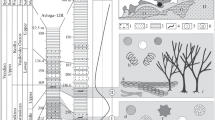Abstract
Remains of uniquely preserved microorganisms are found in silicified columnar stromatolites in the Byuk Formation of the Vendian (Ediacaran) in the Berezovsky Trough, the southeast of the Siberian Platform (southwestern Yakutia). The biological explanation for these microorganism remains has determined their systematic position, as fungi : yeast cells in the mycelium-yeast form, which are parasitic thalli of green algae. Cells (individuals), mycelia, hyphae, buds, mycelium branches, and outgrowths (external curvature sof the cell wall) were preserved. The following patterns have been revealed: apical growth of hyphae; daughter cells that were not separated from the mother cell; parasitism of fungi on algae and osmotrophic pattern of their consumption. A new genus and species, Sakhi solomonovi gen. et sp. nov., are described.




Similar content being viewed by others
REFERENCES
Bartnicki–Garcia, S., The cell wall: a crucial structure in fungal evolution, in Evolutionary Biology of the Fungi, Cambridge: Cambr. Univ. Press, 1987, pp. 389–403.
Bartnicki–Garcia, S., The hypha: unifying thread of the fungal kingdom, in A Century of Mycology, Cambridge: Cambr. Univ. Press, 1996, pp. 105–133.
Bengtson, S., Rasmussen, B., Ivarsson, M., et al., Fungus-like mycelia fossils in 2.4 billion-year-old vesicular basalt, in Nature Ecology & Evolution, online: 2017.
Botanika: Kurs al’gologii i mikologii (Botany: Course of Algology and Mycology), D’yakov, Yu.T., Ed., Moscow: MGU, 2007.
Burzin, M.B., Are the oldest organisms a source of oil on the Russian Platform?, Priroda, 1995, no. 2, pp. 38–44.
Burzin, M.B., Mikroorganizmy v iskopaemoi letopisi (Microorganisms in the fossil record), Moscow: MAKS-Press, 2003.
D’yakov, Yu.T., Zanimatel’naya mikologiya (Recreational mycology), Moscow: Knizhnyi Dom Librokom, 2013.
Emtsev, V.T. and Mishustin, E.N., Mikrobiologiya: uchebnik dlya bakalavrov (Microbiology: Textbook for Bachelors), Moscow: Yurait, 2012.
Gnilovskaya, M.B., Izvestkovye vodorosli srednego i pozdnego ordovika Vostochnogo Kazakhstana (Calcareous Algae of the Middle and Late Ordovician in Eastern Kazakhstan), Leningrad: Nauka, 1972.
Gromov, B.V., Mikroorganizmy—parazity vodoroslei (Microorganisms are Algal Parasites), Leningrad: LGU, 1976.
Karatygin, I.V., Fungal microfossils: contemporary state and problems, Mikologiya segodnya. T. 1 (Modern Mycology. Volume 1), D’yakov, Yu.T. and Sergeev, Yu.V, Eds., Moscow: Natl. Acad. Mycol., 2007, pp. 10–28.
Karatygin, I.V. and Snigirevskaya, N.S., Palaeontological evidence of the origin of the basic taxonomic groups of fungi, Mycol. Phytopathol., 2004, vol. 38, no. 5, pp. 15–31.
Kirk, P.M., Cannon, P.F., Joost, S., and Minter, D.W., Ainsworth and Bisbys Dictionary of the Fungi, CAB International, 2008.
Kolosov, P.N., New microorganisms from the Vendian (Ediacaran) of the Berezovsky trough, southern Siberian platform, Paleontol. J., 2016a, no. 6, pp. 549–556.
Kolosov, P.N., Fungi in the Vendian of Yakutia, in Materialy IX Chtenii pamyati A.N. Krishtofovicha (Proceedings of the 9nt Readings in Memory of A.N. Krishtofovich), St. Petersburg: BIN RAN, 2016b, pp. 11–12.
Lücking, R., Huhndorf, S., Pfister, D.H., et al., Fungi evolved right on track, Mycologia, 2009, vol. 101, pp. 810–822.
Meyen, S.V., Osnovy paleobotaniki (Fundamentals of Paleobotany), Moscow: Nedra, 1987.
Methodology of science: problems and solutions, in Vopr. Filos., 1988, no. 3, pp. 120–123.
Mukhin, V.A. and Tret’yakova A.S., Biologicheskoe raznoobrazie: vodorosli i griby (Biological Diversity. Algae and Fungi), Rostov-on-Don: Feniks, 2013.
Peterson, K.J., Waggoner, B., and Hagadorn, J.W., A fungal analog for Newfoundland Ediacaran fossils, Integr. Comp. Biol., 2003, vol. 43, pp. 127–136.
Retallack, G.J., Were the Ediacaran fossil lichen?, Paleobiology, 1994, vol. 20, pp. 523–544.
Shuysky, V.P., Green algae (Chlorophyta), in Iskopaemye izvestkovye vodorosli (morfologiya, sistematika, metody izucheniya) (Fossil Calcareous Algae: Morphology, Systematics, and Study Methods), Novosibirsk: Nauka, 1987, pp. 38–109.
Wijayawardene, N.N., Hyde, K.D., Al-Ani, L.K.T., et al., Outline of fungi and fungus-like taxa, Mycosphere, 2020, vol. 11, no. 1, pp. 1060–1456. https//doi.org//10.5943/mycosphere/11/1/8
Yuan, X., Xiao, S., and Taylor, T.N., Lichen-like symbiosis 600 million years ago, Science, 2005, vol. 308, pp. 1017–1020.
ACKNOWLEDGMENTS
The author is very grateful to Prof. W.J. Schopf from the California University (United States) for creative collaboration in studying Precambrian microorganisms.
Funding
The study was performed as part of a state order.
Author information
Authors and Affiliations
Corresponding author
Additional information
Translated by D. Zabolotny
Rights and permissions
About this article
Cite this article
Kolosov, P.N. Uniquely Preserved Fungi in the Vendian (Ediacaran) of Yakutia. Paleontol. J. 55, 455–461 (2021). https://doi.org/10.1134/S0031030121040080
Received:
Revised:
Accepted:
Published:
Issue Date:
DOI: https://doi.org/10.1134/S0031030121040080




